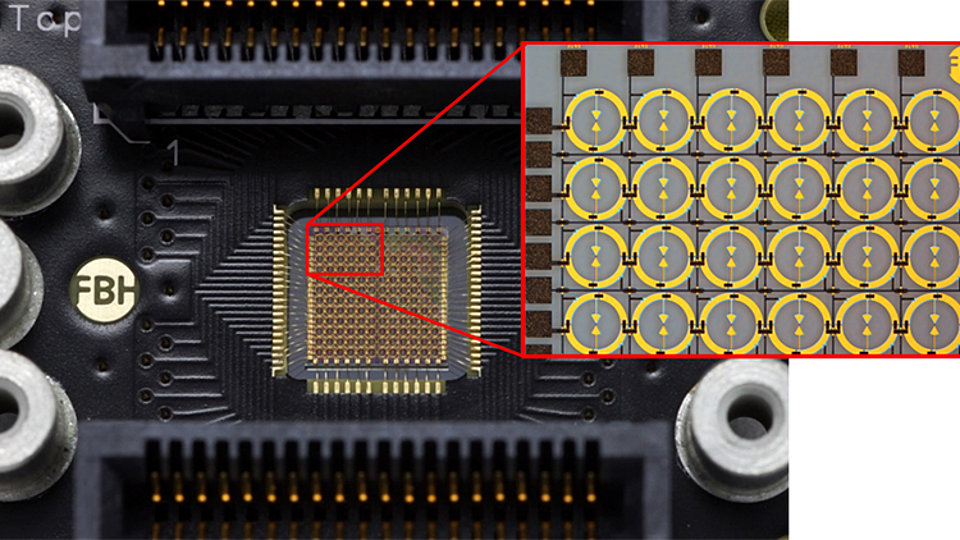GaN HEMT-based THz detectors
The THz range is well suited for various applications in biology, medicine and industry since many materials have a characteristic spectral fingerprint at these frequencies. To make THz frequencies accessible, different research groups have demonstrated FET-based THz detectors at room temperature, realized with transistors operating far beyond their cut-off frequencies. These THz detectors exhibit excellent performance and are an alternative to the classical diode-based approach, especially when considering monolithic integration into large integrated arrays with direct antenna coupling.
Based on its GaN HEMT MMIC process, the FBH develops highly sensitive, fast-response and broadband THz detectors for CW and pulsed operation. To achieve this, different types of epitaxial structures, transistor layouts and antenna structures have been investigated. This gives the unique opportunity to tailor both transistors and antenna structures for use up to several THz. Fig. 1 shows a GaN-based THz detector with a bow-tie antenna structure. The GaN HEMT has a gate width of 3 µm and a gate length of 150 nm. A broadband measurement result of this structure is presented in Fig. 2. In the frequency range from 400 GHz to 1200 GHz, this THz detector exhibits excellent noise equivalent power (NEP) values with best values of 26 pW/√Hz at 500 GHz. At 300 GHz the antenna structure and the GaN HEMT are in mismatch, which causes a lower limit in frequency.
Fast THz cameras with high sensitivity are mandatory for many industrial applications. Therefore, FBH is working on focal plane arrays of THz detectors, in order to transfer the excellent single detector performance to a THz camera. This approach is documented in Fig. 3, presenting a 12 x1 2 pixel focal plane array of bow-tie detectors. The chip area is 5 mm x 5 mm with a pixel pitch of 380 µm.
Publications
D. Čibiraitė, M. Bauer, A. Rämer, S. Chevtchenko, A. Lisauskas, J. Matukas, V. Krozer, W. Heinrich, H. G. Roskos, "Enhanced performance of AlGaN/GaN HEMT-based THz detectors at room temperature and at low temperature", 42. Internat. Conf. on Infrared, Millimeter, and Terahertz Waves (IRMMW-THz), DOI:10.1109/IRMMW-THz.2017.8067118, (2017).
K. Ikamas, A. Lisauskas, M. Bauer, A. Rämer, S. Massabeau, D. Čibiraitė, M. Burakevič, S. Chevtchenko, J. Mangeney, W. Heinrich, "Efficient detection of short-pulse THz radiation with field effect transistors", Internat. Conf. on Noise and Fluctuations (ICNF), DOI: 10.1109/ICNF.2017.7985961, (2017).
D. Čibiraitė, M. Bauer, A. Lisauskas, S. Pralgauskaitė, J. Zdanevičius, J. Matukas, A. Rämer, W. Heinrich, V. Krozer, H. G. Roskos, M. Andersson, J. Stake, "Thermal noise-limited sensitivity of FET-based terahertz detectors", Internat. Conf. on Noise and Fluctuations (ICNF), DOI: 10.1109/ICNF.2017.7986008, (2017)
D. Voß, W. Zouaghi, M. Jamshidifar, S. Boppel, C. McDonnell, J. R. P. Bain, N. Hempler, G. P. A. Malcolm, G. T. Maker, M. Bauer, A. Lisauskas, A. Rämer, S. A. Shevchenko, W. Heinrich, V. Krozer, H. G. Roskos, "Imaging and Spectroscopic Sensing with Low-Repetition-Rate Terahertz Pulses and GaN TeraFET Detectors", Int. J. Infrared Millimeter Terahertz Waves, vol. 39, no. 3, pp. 262-272 (2018).


